Submitted:
02 May 2023
Posted:
03 May 2023
You are already at the latest version
Abstract
Keywords:
1. Introduction
2. Materials and Methods
2.1. Investigation period and study area
2.2. Air pollutants under study
2.3. Data
2.4. Statistical Analysis
- H0: The two distributions are identical, F(x) ≥ G(x) for all x, where F(x) is the lockdown- and G(x) reference period.
- HA: They do not have the same distribution; the lockdown distributions are shifted toward lower values: F(x) < G(x) for at least one x.
- H0ozone: The two distributions are identical, F(x) ≤ G(x) for all x, where F(x) is the lockdown- and G(x) reference period.
- HAozone: They do not have the same distribution; the lockdown distributions are shifted toward higher values: F(x) > G(x) for at least one x.
3. Results
3.1. Multiparameter overview
3.2. Nitrogen Dioxide
3.3. Ozone
3.4. Particulate Matter
3.5. Land Surface Temperature
3.6. Mobility Data
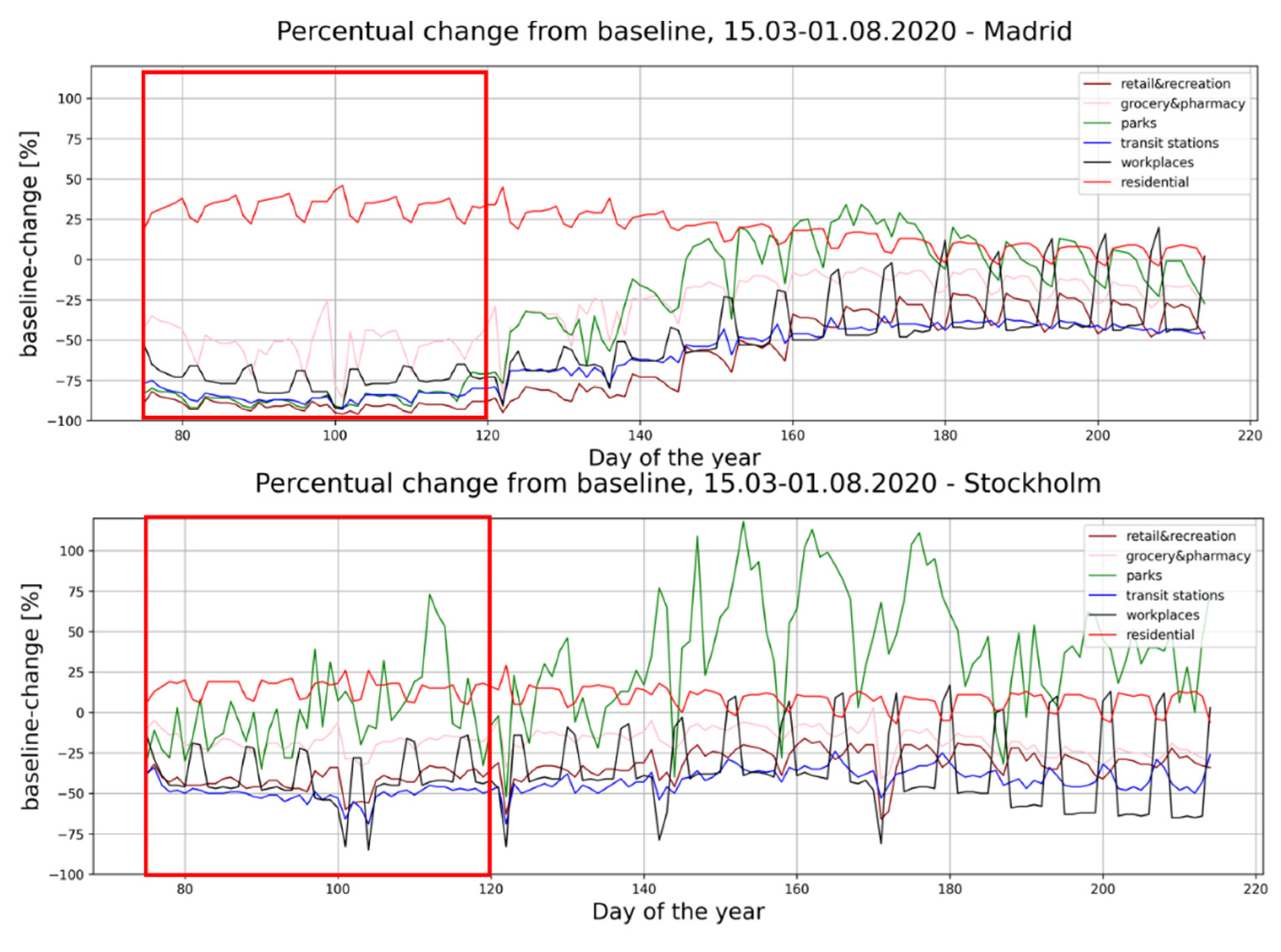
4. Discussion
Nitrogen dioxide
Ozone
Particulate Matter
Relationship of the air quality variables and LST with the mobility data
5. Conclusions
Author Contributions
Funding
Data Availability Statement
Conflicts of Interest
References
- World Health Organization Report of the WHO-China Joint Mission on Coronavirus Disease 2019 (COVID-19) Available online: https://www.who.int/publications-detail-redirect/report-of-the-who-china-joint-mission-on-coronavirus-disease-2019-(covid-19) (accessed on 18 August 2022).
- World Health Organization Coronavirus Available online: https://www.who.int/health-topics/coronavirus (accessed on 28 April 2023).
- World Health Organization WHO Coronavirus (COVID-19) Dashboard Available online: https://covid19.who.int (accessed on 28 April 2023).
- Le Quéré, C.; Jackson, R.B.; Jones, M.W.; Smith, A.J.P.; Abernethy, S.; Andrew, R.M.; De-Gol, A.J.; Willis, D.R.; Shan, Y.; Canadell, J.G.; et al. Temporary Reduction in Daily Global CO2 Emissions during the COVID-19 Forced Confinement. Nat. Clim. Chang. 2020, 10, 647–653. [CrossRef]
- Anania, J.; Mello, B.A. de; Angrist, N.; Barnes, R.; Boby, T.; Cavalieri, A.; Edwards, B.; Webster, S.; Ellen, L.; Furst, R.; et al. Variation in Government Responses to COVID-19. Blavatnik Sch. Government Work. Paper 2022.
- Metya, A.; Dagupta, P.; Halder, S.; Chakraborty, S.; Tiwari, Y.K. COVID-19 Lockdowns Improve Air Quality in the South-East Asian Regions, as Seen by the Remote Sensing Satellites. Aerosol Air Qual. Res. 2020, 20, 1772–1782. [CrossRef]
- Jin, M.; Dickinson, R.E. Land Surface Skin Temperature Climatology: Benefitting from the Strengths of Satellite Observations. Environ. Res. Lett. 2010, 5, 044004. [CrossRef]
- Urban Climates; Oke, T.R., Ed.; Cambridge University Press: Cambridge, 2017; ISBN 978-0-521-84950-0.
- Liu, Z.; Lai, J.; Zhan, W.; Bechtel, B.; Voogt, J.; Quan, J.; Hu, L.; Fu, P.; Huang, F.; Li, L.; et al. Urban Heat Islands Significantly Reduced by COVID-19 Lockdown. Geophysical Research Letters 2022, 49. [CrossRef]
- Hadibasyir, H.Z.; Rijal, S.S.; Sari, D.R. Comparison of Land Surface Temperature During and Before the Emergence of Covid-19 Using Modis Imagery in Wuhan City, China. For. Geo. 2020, 34. [CrossRef]
- Parida, B.R.; Bar, S.; Kaskaoutis, D.; Pandey, A.C.; Polade, S.D.; Goswami, S. Impact of COVID-19 Induced Lockdown on Land Surface Temperature, Aerosol, and Urban Heat in Europe and North America. Sustainable Cities and Society 2021, 75, 103336. [CrossRef]
- Taoufik, M.; Laghlimi, M.; Fekri, A. Comparison of Land Surface Temperature Before, During and After the Covid-19 Lockdown Using Landsat Imagery: A Case Study of Casablanca City, Morocco. GaEE 2021, 15, 105–120. [CrossRef]
- Hidalgo García, D.; Arco Díaz, J. Impacts of the COVID-19 Confinement on Air Quality, the Land Surface Temperature and the Urban Heat Island in Eight Cities of Andalusia (Spain). Remote Sensing Applications: Society and Environment 2022, 25, 100667. [CrossRef]
- Adam, M.G.; Tran, P.T.M.; Balasubramanian, R. Air Quality Changes in Cities during the COVID-19 Lockdown: A Critical Review. Atmospheric Research 2021, 264, 105823. [CrossRef]
- Barré, J.; Petetin, H.; Colette, A.; Guevara, M.; Peuch, V.-H.; Rouil, L.; Engelen, R.; Inness, A.; Flemming, J.; Pérez García-Pando, C.; et al. Estimating Lockdown-Induced European NO<Sub>2</Sub> Changes Using Satellite and Surface Observations and Air Quality Models. Atmos. Chem. Phys. 2021, 21, 7373–7394. [CrossRef]
- Sicard, P.; De Marco, A.; Agathokleous, E.; Feng, Z.; Xu, X.; Paoletti, E.; Rodriguez, J.J.D.; Calatayud, V. Amplified Ozone Pollution in Cities during the COVID-19 Lockdown. Science of The Total Environment 2020, 735, 139542. [CrossRef]
- NASA Earth Science Data Systems Health and Air Quality Data Pathfinder Available online: http://www.earthdata.nasa.gov/learn/pathfinders/health-and-air-quality-data-pathfinder (accessed on 18 August 2022).
- Wijnands, J.S.; Nice, K.A.; Seneviratne, S.; Thompson, J.; Stevenson, M. The Impact of the COVID-19 Pandemic on Air Pollution: A Global Assessment Using Machine Learning Techniques. Atmospheric Pollution Research 2022, 13, 101438. [CrossRef]
- Zhang, Z.; Arshad, A.; Zhang, C.; Hussain, S.; Li, W. Unprecedented Temporary Reduction in Global Air Pollution Associated with COVID-19 Forced Confinement: A Continental and City Scale Analysis. Remote Sensing 2020, 12, 2420. [CrossRef]
- European Space Agency Air Pollution Remains Low as Europeans Stay at Home Available online: https://www.esa.int/Applications/Observing_the_Earth/Copernicus/Sentinel-5P/Air_pollution_remains_low_as_Europeans_stay_at_home (accessed on 18 August 2022).
- Tobías, A.; Carnerero, C.; Reche, C.; Massagué, J.; Via, M.; Minguillón, M.C.; Alastuey, A.; Querol, X. Changes in Air Quality during the Lockdown in Barcelona (Spain) One Month into the SARS-CoV-2 Epidemic. Science of The Total Environment 2020, 726, 138540. [CrossRef]
- He, G.; Pan, Y.; Tanaka, T. The Short-Term Impacts of COVID-19 Lockdown on Urban Air Pollution in China. Nat Sustain 2020, 3, 1005–1011. [CrossRef]
- Nichol, J.E.; Bilal, M.; Ali, Md.A.; Qiu, Z. Air Pollution Scenario over China during COVID-19. Remote Sensing 2020, 12, 2100. [CrossRef]
- Alqasemi, A.S.; Hereher, M.E.; Kaplan, G.; Al-Quraishi, A.M.F.; Saibi, H. Impact of COVID-19 Lockdown upon the Air Quality and Surface Urban Heat Island Intensity over the United Arab Emirates. Science of The Total Environment 2021, 767, 144330. [CrossRef]
- Venter, Z.S.; Aunan, K.; Chowdhury, S.; Lelieveld, J. COVID-19 Lockdowns Cause Global Air Pollution Declines. Proc. Natl. Acad. Sci. U.S.A. 2020, 117, 18984–18990. [CrossRef]
- Beirle, S.; Boersma, K.F.; Platt, U.; Lawrence, M.G.; Wagner, T. Megacity Emissions and Lifetimes of Nitrogen Oxides Probed from Space. Science 2011, 333, 1737–1739. [CrossRef]
- Elshorbany, Y.F.; Kleffmann, J.; Kurtenbach, R.; Rubio, M.; Lissi, E.; Villena, G.; Gramsch, E.; Rickard, A.R.; Pilling, M.J.; Wiesen, P. Summertime Photochemical Ozone Formation in Santiago, Chile. Atmospheric Environment 2009, 43, 6398–6407. [CrossRef]
- European Environment Agency European Union Emission Inventory Report 1990-2018 under the UNECE Convention on Long-Range Transboundary Air Pollution (LRTAP).; Publications Office: LU, 2020;
- Sismanidis, P.; Bechtel, B.; Perry, M.; Ghent, D. The Seasonality of Surface Urban Heat Islands across Climates. Remote Sensing 2022, 14, 2318. [CrossRef]
- Stewart, I.D.; Oke, T.R. Local Climate Zones for Urban Temperature Studies. Bulletin of the American Meteorological Society 2012, 93, 1879–1900. [CrossRef]
- CAMS European Air Quality Information in Support of the COVID-19 Crisis | Copernicus Available online: https://atmosphere.copernicus.eu/european-air-quality-information-support-covid-19-crisis (accessed on 18 August 2022).
- Google LLC COVID-19 Community Mobility Report Available online: https://www.google.com/covid19/mobility?hl=en-GB (accessed on 18 August 2022).
- Gao, X. Nonparametric Statistics. In N. J. Salkind (Ed.), Encyclopedia of Research Design (Pp. 915–920). Thousand Oaks, California: SAGE Publications Ltd. In; 2010.
- Codagnone, C.; Bogliacino, F.; Gómez, C.; Folkvord, F.; Liva, G.; Charris, R.; Montealegre, F.; Lupiañez Villanueva, F.; Veltri, G.A. Restarting “Normal” Life after Covid-19 and the Lockdown: Evidence from Spain, the United Kingdom, and Italy. Soc Indic Res 2021, 158, 241–265. [CrossRef]
- Fairless, T. How Germany Kept Its Factories Open During the Pandemic. Wall Street Journal 2020.
- Menut, L.; Bessagnet, B.; Siour, G.; Mailler, S.; Pennel, R.; Cholakian, A. Impact of Lockdown Measures to Combat Covid-19 on Air Quality over Western Europe. Sci Total Environ 2020, 741, 140426. [CrossRef]
- Rossi, R.; Ceccato, R.; Gastaldi, M. Effect of Road Traffic on Air Pollution. Experimental Evidence from COVID-19 Lockdown. Sustainability 2020, 12, 8984. [CrossRef]
- Masiol, M.; Squizzato, S.; Formenton, G.; Harrison, R.M.; Agostinelli, C. Air Quality across a European Hotspot: Spatial Gradients, Seasonality, Diurnal Cycles and Trends in the Veneto Region, NE Italy. Science of The Total Environment 2017, 576, 210–224. [CrossRef]
- Shi, Z.; Song, C.; Liu, B.; Lu, G.; Xu, J.; Van Vu, T.; Elliott, R.J.R.; Li, W.; Bloss, W.J.; Harrison, R.M. Abrupt but Smaller than Expected Changes in Surface Air Quality Attributable to COVID-19 Lockdowns. Science Advances 2021, 7, eabd6696. [CrossRef]
- Zou, Y.; Charlesworth, E.; Yin, C.Q.; Yan, X.L.; Deng, X.J.; Li, F. The Weekday/Weekend Ozone Differences Induced by the Emissions Change during Summer and Autumn in Guangzhou, China. Atmospheric Environment 2019, 199, 114–126. [CrossRef]
- Adame, J.A.; Hernández-Ceballos, M.Á.; Sorribas, M.; Lozano, A.; Morena, B.A.D. la Weekend-Weekday Effect Assessment for O3, NOx, CO and PM10 in Andalusia, Spain (2003-2008). Aerosol Air Qual. Res. 2014, 14, 1862–1874. [CrossRef]
- Hörmann, S.; Jammoul, F.; Kuenzer, T.; Stadlober, E. Separating the Impact of Gradual Lockdown Measures on Air Pollutants from Seasonal Variability. Atmospheric Pollution Research 2021, 12, 84–92. [CrossRef]
- Munir, S.; Coskuner, G.; Jassim, M.S.; Aina, Y.A.; Ali, A.; Mayfield, M. Changes in Air Quality Associated with Mobility Trends and Meteorological Conditions during COVID-19 Lockdown in Northern England, UK. Atmosphere 2021, 12, 504. [CrossRef]
- Shanableh, A.; Al-Ruzouq, R.; Khalil, M.A.; Gibril, M.B.A.; Hamad, K.; Alhosani, M.; Stietiya, M.H.; Bardan, M.A.; Mansoori, S.A.; Hammouri, N.A. COVID-19 Lockdown and the Impact on Mobility, Air Quality, and Utility Consumption: A Case Study from Sharjah, United Arab Emirates. Sustainability 2022, 14, 1767. [CrossRef]
- Hale, T.; Angrist, N.; Goldszmidt, R.; Kira, B.; Petherick, A.; Phillips, T.; Webster, S.; Cameron-Blake, E.; Hallas, L.; Majumdar, S.; et al. A Global Panel Database of Pandemic Policies (Oxford COVID-19 Government Response Tracker). Nat Hum Behav 2021, 5, 529–538. [CrossRef]
- Ropkins, K.; Tate, J.E. Early Observations on the Impact of the COVID-19 Lockdown on Air Quality Trends across the UK. Sci Total Environ 2021, 754, 142374. [CrossRef]
- Efe, B. Air Quality Improvement and Its Relation to Mobility during COVID-19 Lockdown in Marmara Region, Turkey. Environ Monit Assess 2022, 194, 255. [CrossRef]
- Gorrochategui, E.; Hernandez, I.; Pérez-Gabucio, E.; Lacorte, S.; Tauler, R. Temporal Air Quality (NO2, O3, and PM10) Changes in Urban and Rural Stations in Catalonia during COVID-19 Lockdown: An Association with Human Mobility and Satellite Data. Environ Sci Pollut Res 2022, 29, 18905–18922. [CrossRef]
- Munir, S.; Mayfield, M.; Coca, D.; Mihaylova, L.; Osammor, O. Analysis of Air Pollution in Urban Areas with Airviro Dispersion Model—A Case Study in the City of Sheffield, United Kingdom. Atmosphere 2020, 11, 285. [CrossRef]
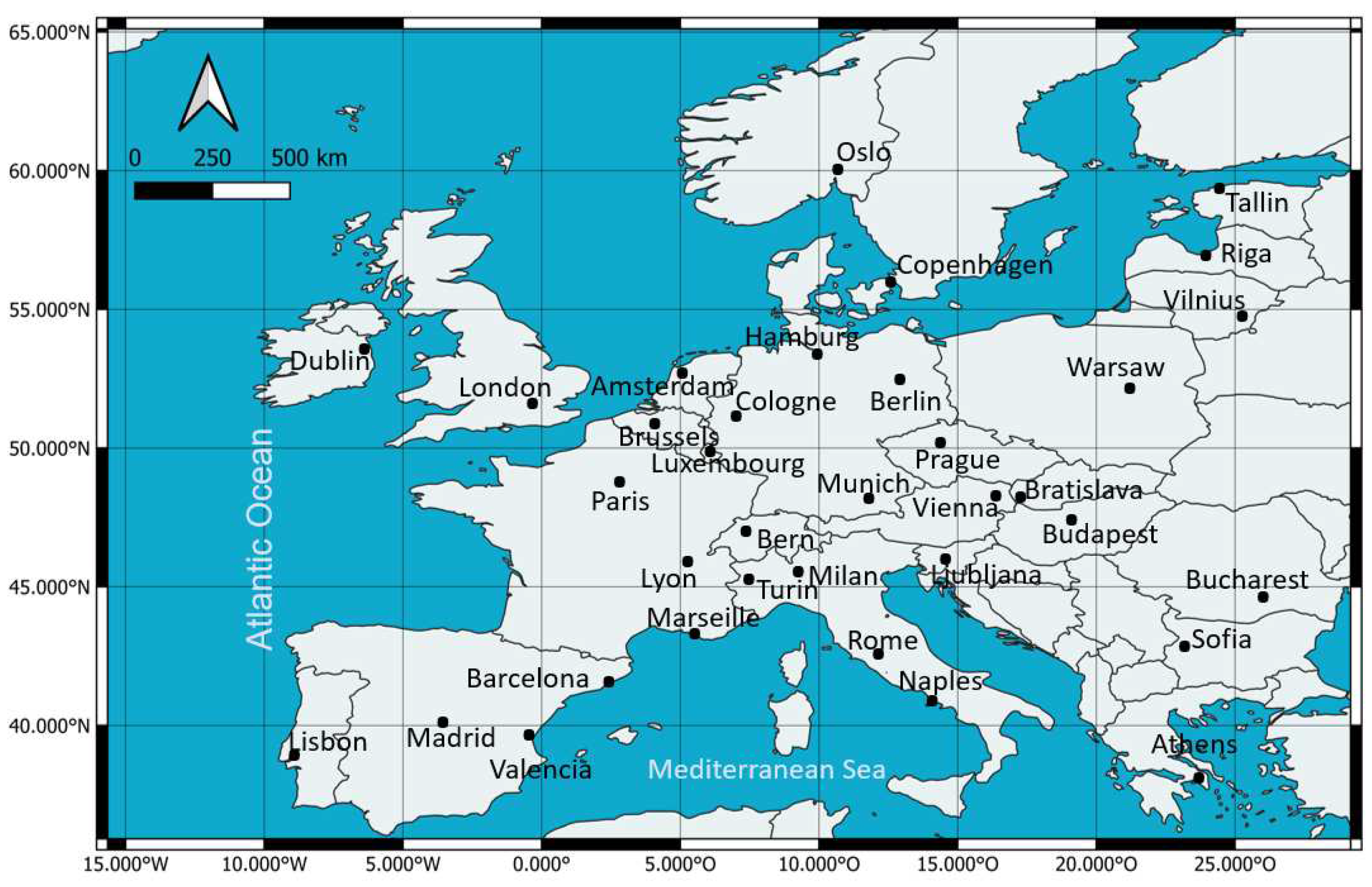





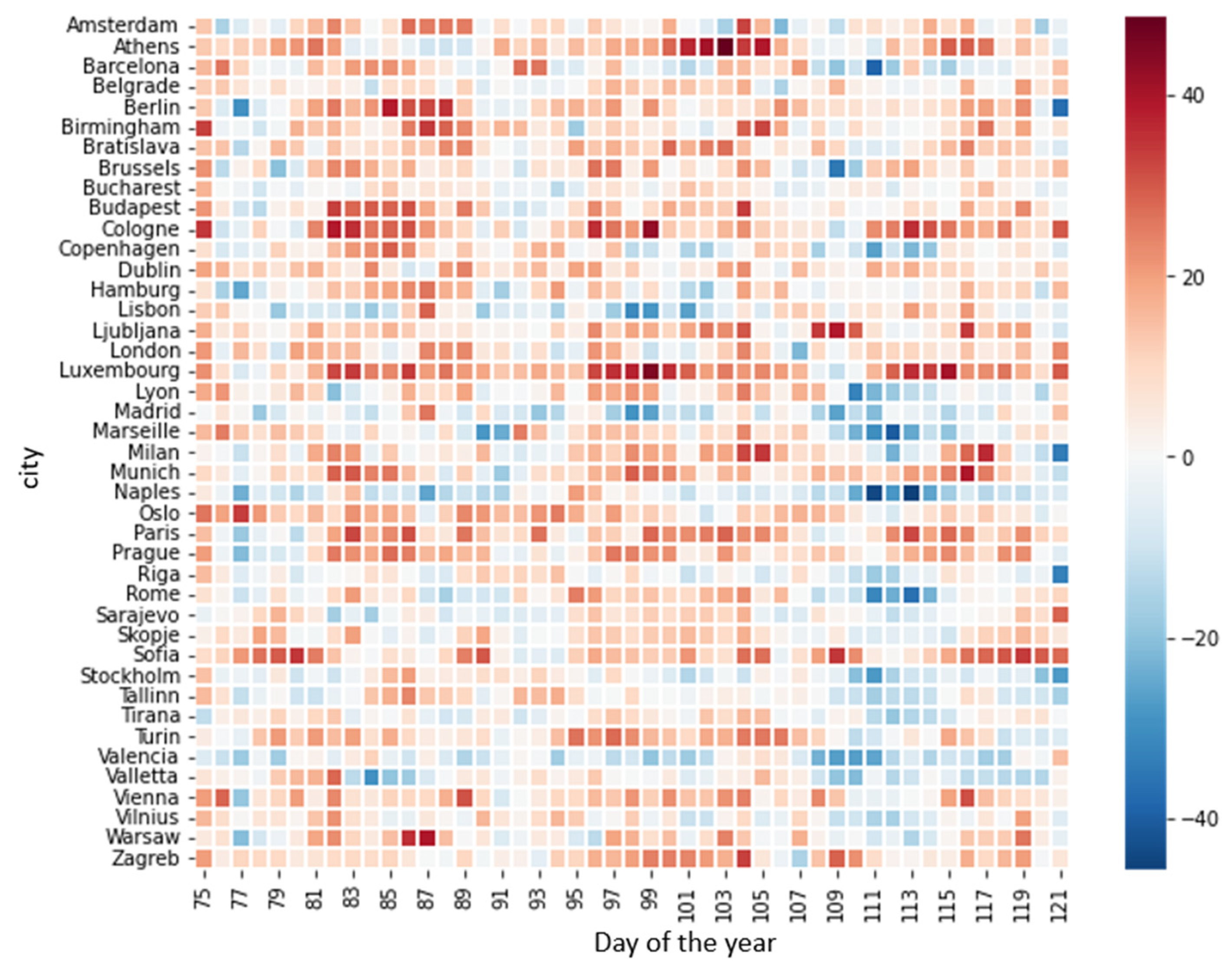
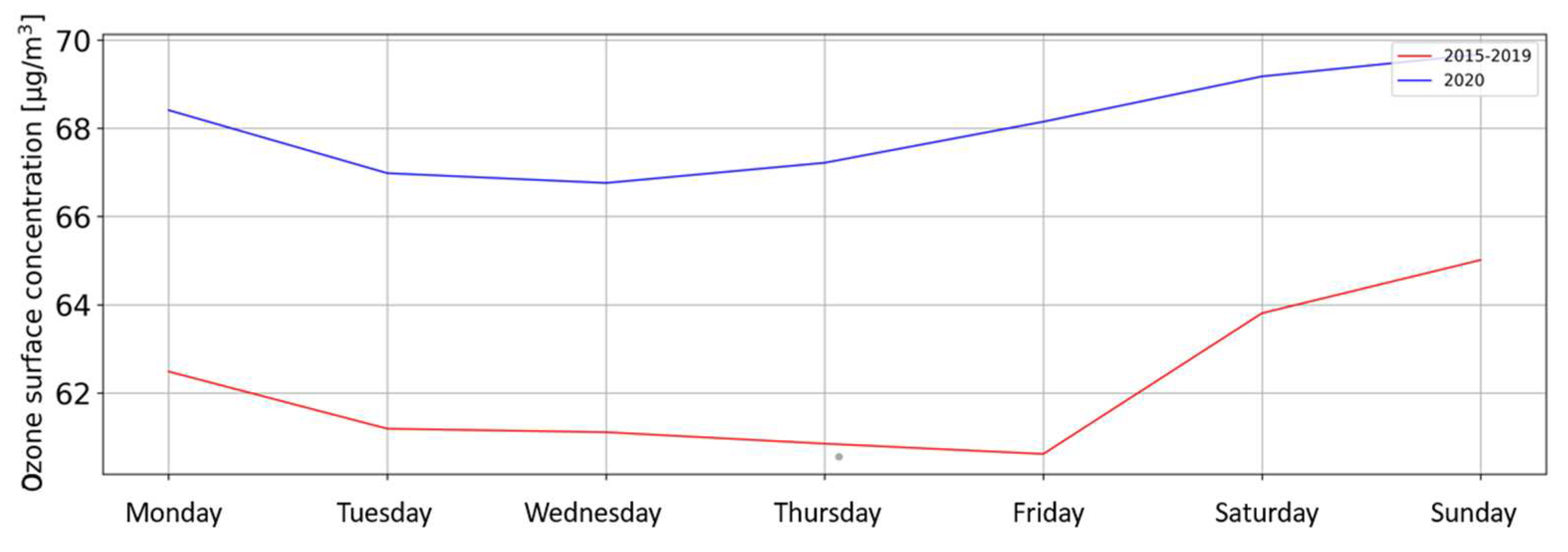



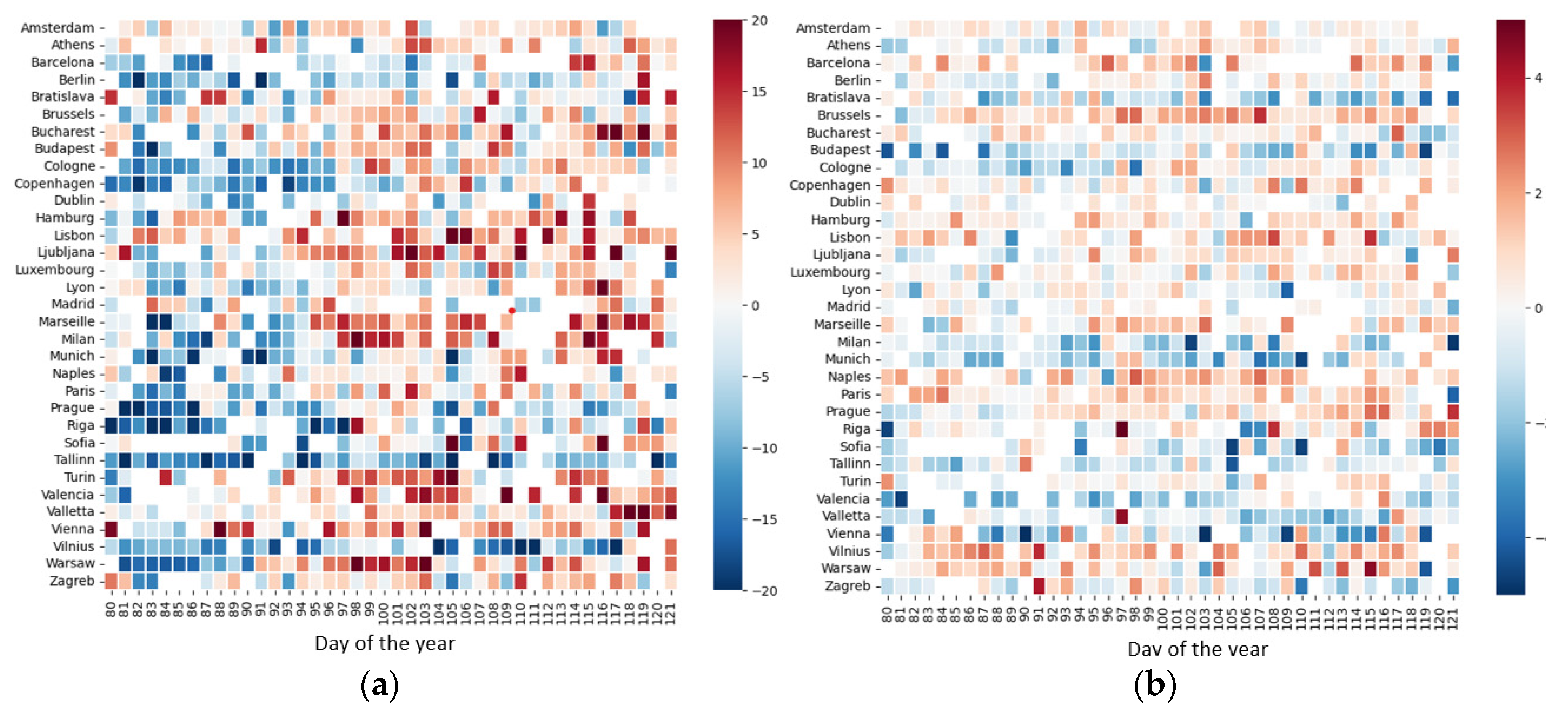

Disclaimer/Publisher’s Note: The statements, opinions and data contained in all publications are solely those of the individual author(s) and contributor(s) and not of MDPI and/or the editor(s). MDPI and/or the editor(s) disclaim responsibility for any injury to people or property resulting from any ideas, methods, instructions or products referred to in the content. |
© 2023 by the authors. Licensee MDPI, Basel, Switzerland. This article is an open access article distributed under the terms and conditions of the Creative Commons Attribution (CC BY) license (http://creativecommons.org/licenses/by/4.0/).




